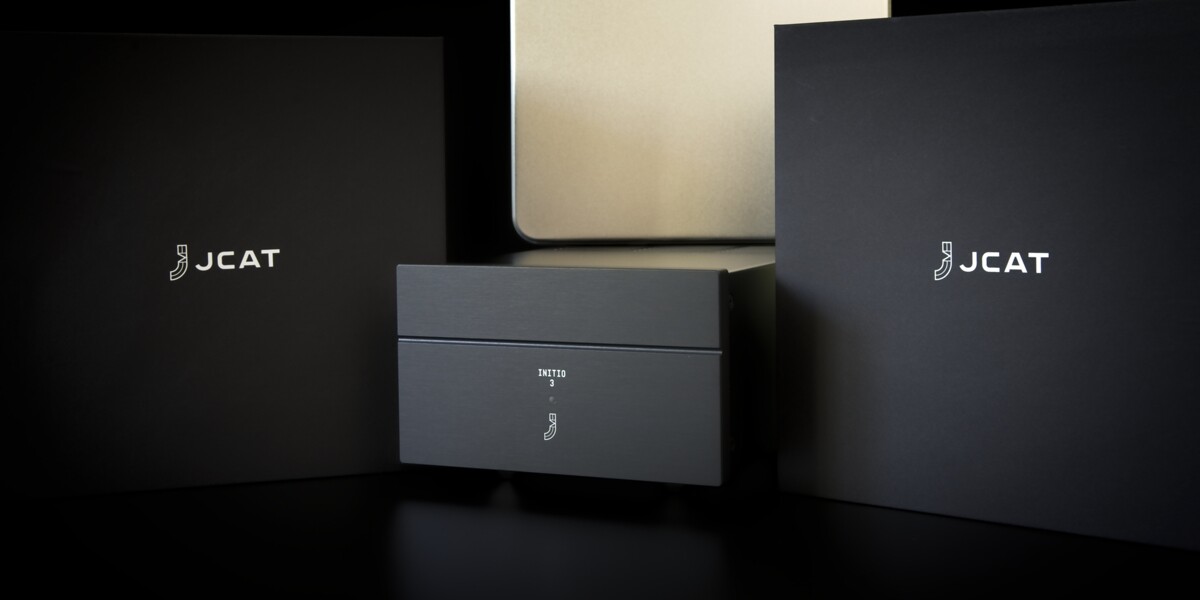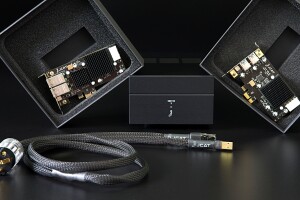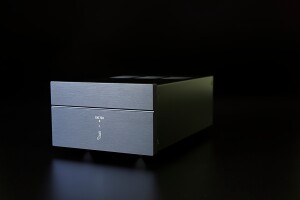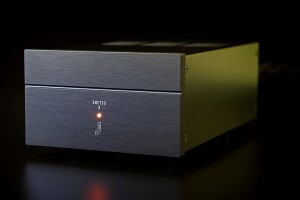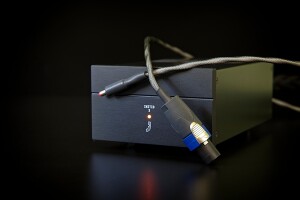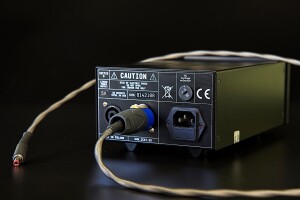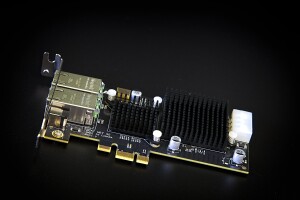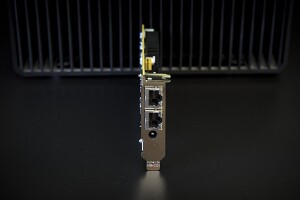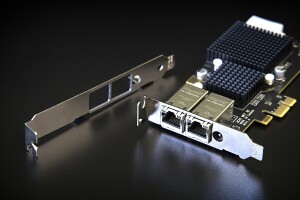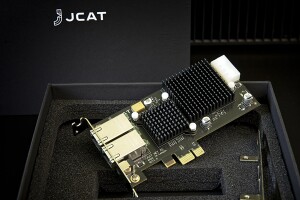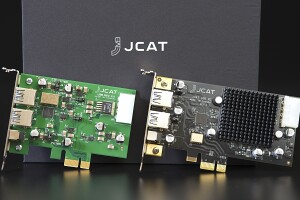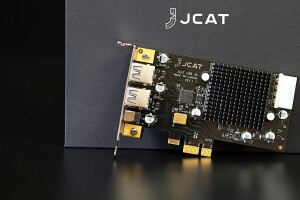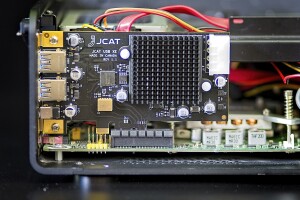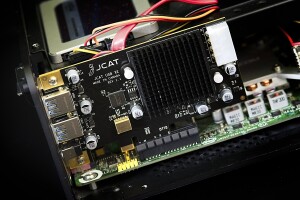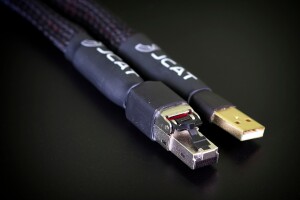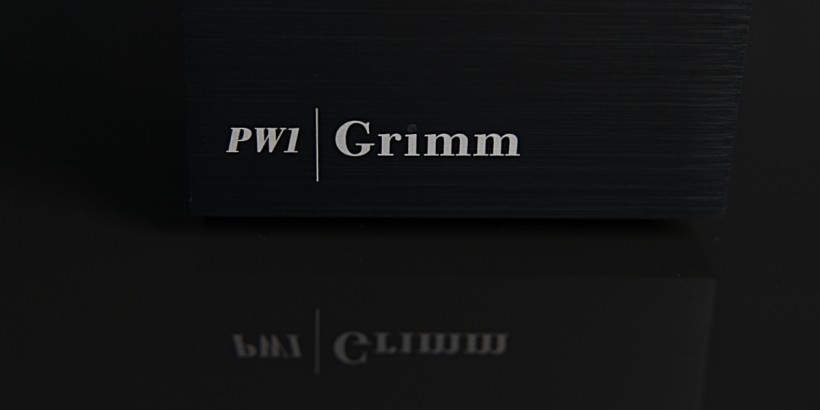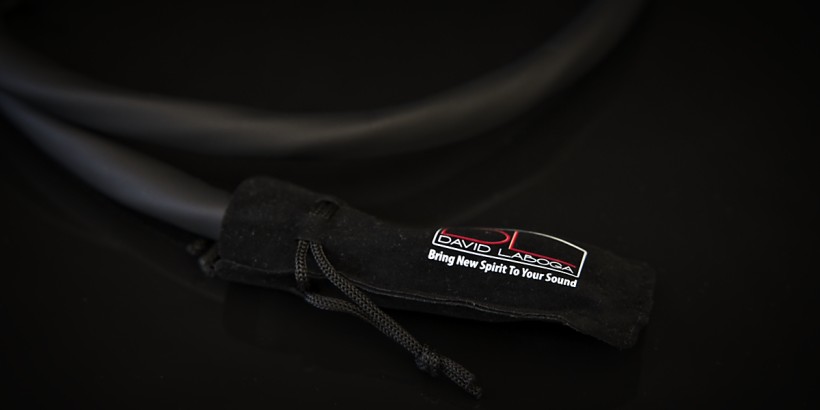This time, I took on a test of several components that are intended to enhance a sonic experience while listening to music from audio files. All these products come from the renown Polish brand JCAT, one of the leaders of the PC audio world. I decided to test some of their latest proposals in my custom music server including: JCAT USB Card XE and JCAT NET Card XE – top models in the range, supported by the company’s INITIO 3 linear power supply. To make things even more interested I asked also for the JCAT USB + LAN Ground Conditioner.
Introduction
There are two types of fans of music played from audio files, at least among those who truly care about sound quality. Some of them simply purchase finished products choosing from hundreds available on the market, treating them the same as any other audio component. But there are also those who prefer to „get their hands dirty” and build something (audio server) on their own. Such a task of building one’s own component may turn out to be a less costly solution (although to achieve truly satisfying sonic results costs more that one may think) but also can be a source of great satisfaction when a self-assembled source “sounds” (of course it does not have it’s own sound, but rather influences the performance of a digital-to-analog converter) equally well, or maybe even better than a of-the shelf one. I am not trying to suggest that one of these approaches is by definition better than the other – it is a matter of individual choice, based partially on a budget, and so on. However, it is the do it yourself type of customer, yours truly included, that the JCAT’s lineup has always been addressed to. We haven’t seen a complete server from Marcin Ostapowicz, the head of JCAT, just yet, but his brand has been offering more and more high and top-class components that allow audiophiles who are not afraid to roll up their sleeves to build their own high-class music server.
Theoretically, you do not need much to build such a generic server – some chassis, a motherboard, CPU, RAM, hard drive and a power supply (preferably all these elements with passive cooling), just a touch of basic PC knowledge and manual skills and that’s it – you have your very basic server. That’s how I started several years ago choosing specific components based on some advice from … no other than Marcin Ostapowicz, who at the time was already becoming an audio-computer guru. For his company it all started with the JPlay software player, and only later he founded a separate brand offering hardware called JCAT, whose components are subjects of this test. Say, you already have such a basic server and it is probably doing a decent job. But, as we all know, audiophiles always look for ways to improve their sonic experience. To do that one may use a number of specialized components that should impact significantly a quality of signal the server sends out to DAC, and thus its performance. You can start with a decent linear power supply – there are more and more of these on the market and even in Poland we already have quite a large group of their manufacturers. You can find inexpensive propositions, as well as advanced, so more expensive ones, such as JCAT’s (but for now offering max DC current of 12V) or Ferrum (with adjustable output voltage). As you can read on the JCAT.eu blog, the ATX power supply from this brand should also be available on the market soon.
Depending on what type of connection with the DAC you want to use, the next step may be about adding an audiophile USB and / or LAN (NET) card. Each of them should also be supported with a linear power supply. For those looking for even more upgrades there is plenty of audiophile switches, cables, including those for internal connections inside the server, LAN / USB isolators, and other devices whose job is to improve the quality of the signal that ultimately goes from the server to the digital-to-analog converter (for the purpose of this text let’s forget about software side of any audio server). You will find many such solutions in the JCAT’s lineup. The latest additions to it include the top versions of USB and NET cards, two linear power supplies – INITIO 3 and OPTIMO 3 DUO, as well as the JCAT USB + LAN Ground Conditioner. The purpose of this assessment is to check in my system if and what they bring to the table.
Design and features
Both cards, USB and NET in the XE version are best distinguished from their predecessors by the color of the laminate – previously a green one was used, new cards are black. The new products are also physically slightly larger (longer). The JCAT NET XE card is an audiophile PCI Express GbE LAN adapter. It is delivered (similarly to USB) with two PCI brackets, a low-profile and full-height ones, so that it can be installed in a “normal” chassis, as well as in a smaller one, often used for mini audio servers, provided that the motherboard features a PCI Express 2.0 slot (x1-x16). No additional drivers are needed if you use any Windows, Linux, but also Roon Rock OS. Both cards can be powered via a molex connector or from an external DC power supply via a 2.1 / 5.5mm connector (with positive central pin). The recommended solutions are obviously the JCAT’s own INITIO 3 or OPTIMO 3 DUO. The manufacturer points out to following features that give the NET XE card the edge over other solutions:
– State-of-the-art LT3045 linear regulators and filters eliminate noise interferences from PC
– Truly linear design: no switching power supplies
– Cutting edge ±5 ppb stability Emerald OCXO (oven controlled oscillator) delivers the most stable timing in the presence of environmental stressors such as airflow, temperature perturbation, vibration, shock, and electromagnetic interference (EMI)
– Highest quality industrial grade components with operating temperature range from -40*C to +85*C
– Enterprise level high performance Intel i350 Ethernet controller
– Gold plated high durability EMI shielded RJ-45 connectors with built-in 12-core transformers for improved isolation
– Two audiophile grade network adapter ports supporting up to 1Gbit connection speeds
– LED-off feature to counteract noise
In the case of the XE USB card, the same LT3045 linear regulators and filters eliminating noise interferences from PC were used, the Emerald OCXO clock and the highest-class components working stably in the temperature range from -40*C to + 85*C. Again, you will find the interchangeable brackets in a box, the card plugs into an available PCI Express 2.0 slot (x1-x16) and one can power it through a molex connector, or from an external DC power supply via a 2.1 / 5.5mm connector (central pin positive). Additional elements include a new generation USB controller – the ASM3142 USB 3.1, gold-plated, EMI shielded USB Audio ports compatible with the following standards: Low Speed (1.5 Mbps), Full-Speed (12 Mbps), Hi-Speed (480 Mbps) and Super-Speed (5 Gbps). The card supports all lossless audio file formats and sampling rates.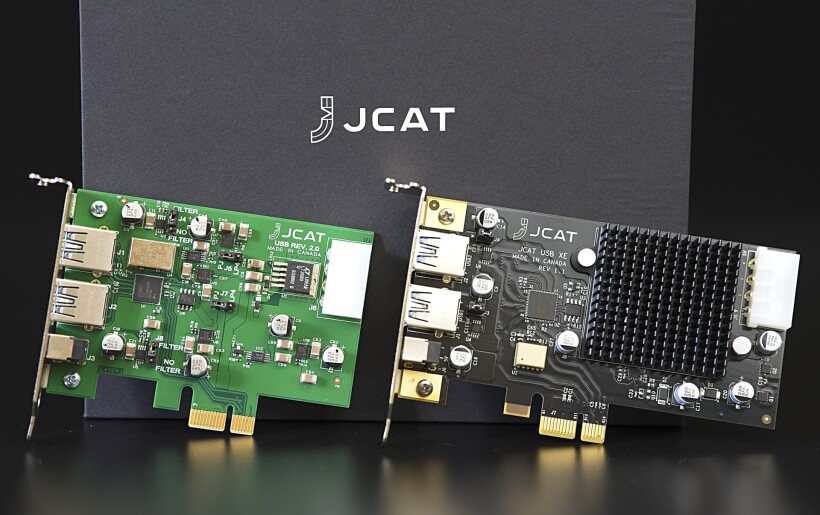
The INITIO 3 is a linear power supply featuring two outputs – when ordering, customers need to state the value they require, namely either 5 or 12V. The maximum output current this power supply is able to deliver is 3A, regardless of whether we use it to power one or two devices. The solid, nicely finished chassis is made of a single sheet of bent steel finished in black, which, together with the aluminum front, ensures adequate rigidity of the entire structure. When developing the INITIO 3, its designers used a number of solutions from the top model, the OPTIMO 3 DUO, including the same ultra-low-noise LT3045 linear voltage regulators and CAT ultra-fast low noise rectifier. The tested device uses a bespoke transformer with magnetic and electrical shielding that is sealed with epoxy resin which greatly reduces harmful vibrations. All components and connectors have been selected for their highest quality. The power supply features multiple protection circuits to guarantee safe and trouble-free operation for many years, including thermal and overload protection. The device is supplied with a custom 1.2 m long shielded DC cable. 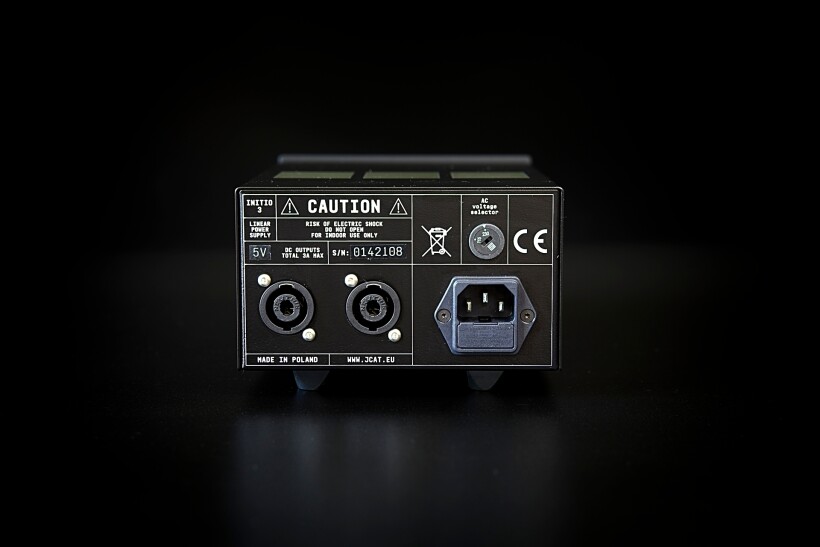
The JCAT USB + LAN Ground Conditioner looks a lot like a power cable. Not quite, as while its one end is terminated with a high quality Schuko plug (alternatively with plugs suitable for UK and US markets), the other, split into two runs, is terminated with high quality USB and RJ45 plugs. The latter ones plug into respective available ports in the music server (one of the options it to use available ports in the JCAT USB or NET cards). In this way, the server motherboard is grounded, and the conditioner’s task is to get rid of the noise generated in the computer. Inside the fairly flexible cable finished with a gray sleeve there is only a grounding conductor made of the highest purity OCC copper. The manufacturer also took care of the excellent shielding of the cable. The standard length of the JCAT USB + LAN Ground Conditioner is 1.3m.
Sound
It doesn’t happen too often that a whole group of products comes for a review from one manufacturer at the same time and I know that each of them can noticeably or even significantly influence the sound of my system. In this case all of them were intended to improve the performance of one of my two main sources – a completely passive audio server built several years ago. Over the years, it has undergone gradual changes, each of which brought another greater or lesser improvement to the sound. From the beginning, it hosted the original JCAT USB card, which was later replaced by a newer version, the Femto, that introduced a significant performance improvement. For a long time I also used JPlay, which is a software player from Marcin’s second brand. More was happening around the server, so to speak. Its initially used switched-mode power supply was replaced with a linear one by HDPlex, and later with the KECES P8 (and the former now powers the NAS where I store all audio files), and an external Bakoon power supply was added for the JCAT USB card. There have been several USB cable and digital-to-analog converters replacements too. More than a year ago I also added the excellent USB signal regenerator from the Ideon Audio (see HERE). At some point I bought an optical LAN separator – back then JCAT did not offer its own, so I bought a medical grade device and have been using it ever since.
As I’ve mentioned, each of these upgrades introduced another improvement to the sound. The first step, i.e. switching from a laptop to a custom audio server resulted in a significant leap in quality, and the later addition of a linear power supply seemed to be the so-called icing on the cake, although the scale this improvement in sound quality was substantial, not just „decorative”. As it turned out later, there was still a long way ahead of me, as the next, already mentioned, small steps, and the larger ones in the form of subsequent DAC replacements, amounted to the server becoming the main digital source in my reference system. This digital front end combined with an analogue one including the outstanding J.Sikora turntable, are currently my trusted partners when it comes to reviewing even the most expensive components. The latest upgrades to my digital system were the addition of a LAN input in my LampizatOr Pacific, which allowed me to use alternatively USB and Ethernet outputs as source of a signal for DAC, replacing my previous USB cables with Polish products by David Laboga (test HERE), and finally adding the Silent Angel Bonn N8 switch with the Forester 1 linear power supply.
My digital front-end benefiting from all these additions and upgrades allows my system to sound really good, at least to my ears, and to be honest I have been quite satisfied with the achieved performance. But the audiophile nature does not allow me (as well as many other music lovers) to enjoy what I have for too long. Constant testing of various components makes me fully aware that no matter how good my system is, there is always some room for improvement. So a while ago I started to think about what, without putting half of the internal organs up for sale, I could add / change in the setup to improve at least some aspects of the sound so that in the end the musical experience would become even more satisfying. As a fan of live music I had been trying for a long time to develop my system in such a way as to achieve a sound that would be as close to the one I remembered from live performances as possible (I’m talking particularly about those in small venues, preferably acoustic ones, not about some stadium madness, even though I do enjoy those from time to time as well).
I focused my efforts on improving the quality of the signal that enters inputs of my excellent LampizatOr Pacific. So I asked Marcin Ostapowicz to send me for a test his latest, top versions of the USB and NET cards. I assumed that I would compare the former with its predecessor, that I owned, and the latter with a LAN port integrated in the motherboard. Since both new cards are a bit more power-hungry than their predecessors, and in their pursuit of perfection, JCAT decided not to leave the current quality to chance anymore and developed its own specialized devices. That’s why the review set also included a linear power supply (the cheaper of the two in the current lineup) called INITIO 3. It so happened, that simultaneously I also got for a review the Ferrum HYPSOS power supply, which, due to the adjustable voltage output, I was able to compare directly to the INITIO 3 (both in this comparison powered mainly the JCAT NET XE card).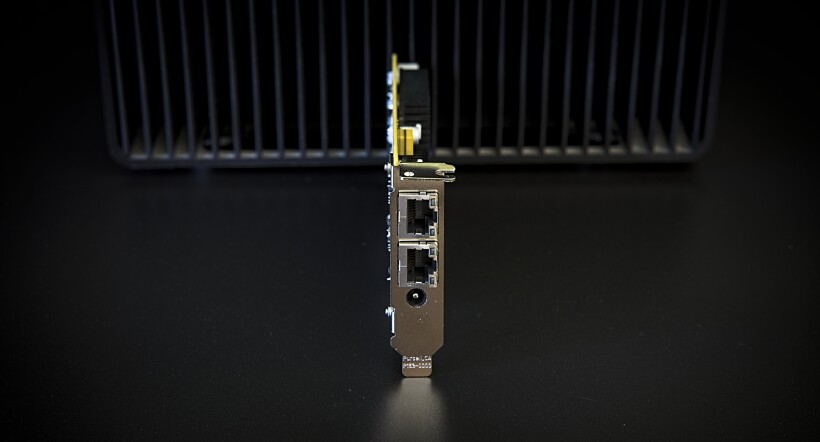
While browsing the JCAT website, one more product caught my eye – the USB + LAN Ground Conditioner. To put it simply, it is a cable with a Schuko plug on one end and a USB (type A) and RJ45 plugs on the other. I have mentioned it many times in my reviews that one of the best USB and LAN cables I have ever tried in my system were products of the Polish brand StavEssence. In each of these cables their designer led out a grounding conductor ended with a “clip”, and the latter could be attached to a “bare” wire that was a part of a “power cable” terminated with a Schuko plug. The point in both cases, ie StavEssence’s and JCAT’s, is that these mains cables contain only ground wires. So they only act as a ground. In my opinion, it was this unusual solution that, to a at least some extent, determined the exceptional class of Karol Staworko’s cables. Marcin Ostapowicz’s product, at least as I assumed it, was a more elegant (although the question was whether it was equally effective) solution, that could offer a similar effect. So I asked for it, planning a comparison with a completely different device that I’d been using in my system already, namely the Acoustic Revive RGC-24 TripleC-FM ground conditioner. And that’s how we arrived at the full set that JCAT sent for this review.
Having so many products at the same time for comparisons, I had to think through the test methodology – how and which components to compare. I think it will be clearest for you if I describe the individual “duels”, some of them summarized briefly, others in a bit more elaborate fashion, depending on what I heard.
JCAT NET Card XE with INITIO 3 vs without additional power supply vs integrated LAN port
The JCAT NET XE can be powered in three ways. First, through a PCI-e slot that it is plugged into in the server’s motherboard. This solution is, by definition, is the worst, even if the entire computer is powered by a linear power supply (as it is my case), as the motherboard and all the components on it “pollute” the current that feeds the card. The card also features a molex connector, which allows it to be powered even from a standard computer power supply. For me this was not an option for any of the cards, because I do not use the appropriate type of power supply. And finally, the last, recommended option, is an external 5-volt DC power supply, plugged into the 2.1 / 5.5mm socket located on the bracket of the card. Of course, the manufacturer strongly suggests using one of their own products – the top OPTIMO 3 DUO, or the one that actually arrived for the test, the INITIO 3. The former, according to Marcin, offers an even better sound (greater impact on the sound), but it is priced accordingly. There are many 5-volt DC power supplies on the market, but according to JCAT, not all of them are able to properly power the JCAT cards as those require a minimum current of 1,5A, while most 5V DC power supplies are capable of delivering only up to 1A. Obviously, Marcin’s own products meet this requirement.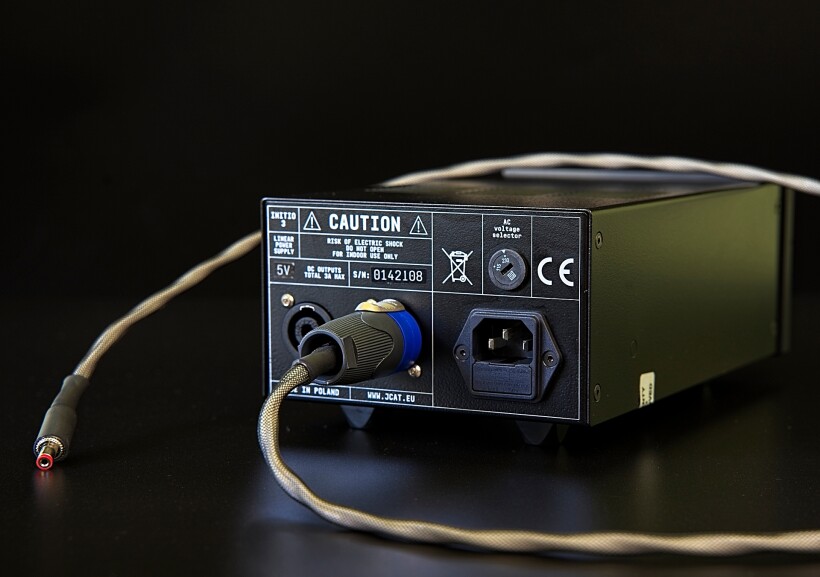
The comparison between the NET XE card powered directly from PCI-e and supported by the INITIO 3 power supply seemed to have a predetermined outcome. However, taking into account that the JCAT NET XE card itself and the JCAT’s power supply do not come cheap, some potential buyers may be interested in knowing whether it is worth buying just the card for starters and adding an external power supply to it later. In other words, does the JCAT NET XE make a significant difference compared to an integrated LAN port even without a dedicated power supply. To squeeze the last juices out of the server and JCAT card in the test, I used two David Laboga LAN cables, the Digital Sound Wave Sapphire model (tested at the same time). They alone (two of them, because I plugged one between the switch and the DAC, the other between the switch and the server) made a significant impact on the performance, so big actually, that I didn’t expect much more from using the JCAT card. Still, to check if and how it would affect the sound, I chose several high resolution tracks, both in PCM and DSD, and started listening.
First, I left the INITIO 3 out of the equation, and compared the sound with the LAN cable plugged into an integrated RJ45 socket with one (of the two) in the JCAT NET XE card powered via the PCI-e slot. After a while I started to wonder, how such a comparison would fare in a larger group audiophiles. For me from the very first moment the sound with the tested card sounded “darker”. I know from experience that some people are discouraged by such a first impression. The fact is, though, that many, if not most, of the best audio components can be described in this way. The impression results from a much better resolution, better saturation and filling of the sound than is the case of most lesser-class components.
With the card there is much more, better pronounced information in the sound, or, much like in a higher resolution picture or video, there is more information within the same space, which makes the sound appear denser, hence darker. One has to notice though, that this “darkness” of the sound is accompanied by a higher tonal intensity, better dynamics and higher clarity of the sound (even if it sounds like a contradiction). All you need to do is to listen carefully to clearly hear elements that (in this case without the JCAT NET XE card) you could barely hear before, or didn’t hear them at all, even though they were captured in the recording. All these elements combined, without being exaggerated or emphasized, contributed to a fuller, richer, more saturated, more engaging and more natural sounding performances. The differences between the tested card (without a power supply) and the integrated LAN socket were easy to notice, but not as great as you might expect after spending 800 Euro. The purchase of the card itself without any prospects of adding a power supply in the future would not be easy to justify, although obviously when it comes to high-end systems, any progress, even a small one, usually costs a lot, and from the point of view of a perfectionist, is fully justified.
Of course, the aforementioned elements of the sound, the improvements, did not change when I connected the external power supply to the card. They were still there, deepened or enhanced. With the INITIO 3 in play, if I had to define the difference in sound with the JCAT NET XE card powered directly from the motherboard and with the JCAT’s PS and use only one word to do it, it would be: definition. This was a constant conclusion valid each time I switched the INITIO 3 on and off. Of course, that’s not the only difference, but it was the clearest, “defining” addition of this LPS for me. This “definition” I am talking about, de facto consisted of at least a few elements. Let me start by explaining that I mean both the definition of individual sounds and the major events on stage, including the spatial aspects of each recording. With the INITIO 3, each of them was clearer, better laid down, which in turn resulted in a better differentiation in terms of tonality, dynamics, three-dimensionality of phantom images and their location in the space/on the soundstage. Each of them had clearer, but not exaggerated outlines, but was also better filled in, so to speak, and the whole presentation was simply more focused. Some of these advantages resulted directly from what is usually attributed to a better power supply – blacker background, lower level of (this inaudible, but present) noise, but the progress (especially compared to the integrated LAN port) was huge, maybe even larger than what I usually notice when upgrading a power supply for any other link of the whole system.
To sum up this part of the test – the difference between an integrated LAN port and the top JCAT NET XE card combined with the INITIO 3 linear power supply was huge. The sound improved dramatically. As I’d mentioned earlier, my system sounded really good without these components, but plugging them in made a dramatic positive difference, one of the “I can’t imagine going back to listening without them” kind. As a result the JCAT NET XE landed on the list of components I had to purchase, while the INITIO 3 on the “maybe” list, but only because I wanted first to compare it with the second promising power supply I had at my disposal. The very need of buying a high-class power supply for the card was a given, it was just about choosing which one.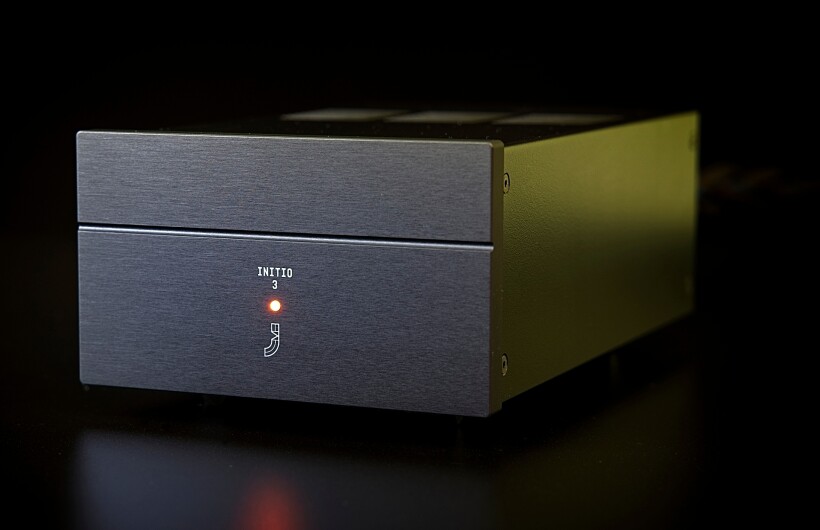
So using the opportunity of having another top quality Polish power supply at my disposal, the aforementioned HYPSOS Ferrum, which is a hybrid design for a change, i.e. partly linear and partly switched mode one, which is to combine the advantages of both solutions, I decided to check if I would be able to detect the differences between these two when using them with the JCAT NET XE card. A separate review of the HYPSOS (actually of two versions of it) is coming, so I won’t go into details here, but it is worth mentioning that one of the advantages of the Ferrum is an adjustable DC output which makes it a versatile device capable of supplying a great number of devices with various current requirements. Due to its versatility selecting the 5V and with a positive central pin, i.e. meeting the requirements of the JCAT NET XE card, was simple – it took me about half a minute or less.
More details will come in its own review so let me only briefly sum up the result of a comparison between these two fantastic devices. Hearing the differences in the sound coming from the speakers when using one or the other PS did not require long listening sessions. Long story short, in this comparison, the INITIO 3 was primarily about nicely weighted and saturated sound, about more powerful, but still well-controlled bass. With the HYPSOS the sound was a bit faster, even more transparent, but not quite as rich and dense. The former helped to built a musical image in which even the spaces between the sounds were denser, which made everything that unfolded in front of me seemed to be a continuous, saturated whole. The latter offered a more analytical insight into the events on stage, more based on the precision of the shapes of phantom images, on their distinctiveness, on a perfect separation. Both though allowed for an even better use of the wealth of acoustic cues contained in the recordings, which made the differences in the quality of the recordings / files even clearer and the presentation more convincing, more immersive.
So which one of these two is a better partner for the JCAT NET XE card? I honestly can’t tell and I am not trying to diplomatically avoid the answer. Simply put, both are fantastic and will greatly, though differently enough fit into different expectations. Those who prefer a more precise sound, with more emphasized details, who prefer everything on the stage drawn with a sharper line, will most likely choose the HYPSOS. Those who, in turn, want to have a highly resolving sound, but with such an abundance of information used more to create an extremely rich, smooth whole rather than to enable them to study individual elements of the performance, will choose INITIO 3. Obviously, this is my opinion, my assessment of the results in a particular system. So surely, if you are looking for this type of device, and these two are within your reach price-wise it is worth checking them both out, verifying my assessment and only than making an informed decision. I have no doubt though, that each of these choices will be a good one. It would be very difficult for me to choose the right one for me among them, although I surely will, because I’ll need one for the JCAT NET XE card. On the one hand, already for quite some time (as it was not always the case), I’ve come to believe that the sources should be as neutral, clean and transparent as possible, so that the sonic character of an amplifier determines the final sound of the whole system. On the other hand, as a fan of tubes and SET amplifiers in particular, I just love a dense, rich, smooth, natural sound, even if it means a slight (!) deviation from neutrality. For my reviewer’s needs I guess the HYPSOS would be a more practical choice, for my own taste the INITIO 3 would be the one, I think…
JCAT USB Card Femto vs JCAT USB Card XE, both with INITIO 3
As I’ve already mentioned, I have been using the Femto USB card almost ever since it was introduced, and in my server it replaced the original version of the JCAT USB card. So I started the listening session by replacing the Bakoon power supply with the INITIO 3, but still with the Femto card. There was a difference in favor of the JCAT power supply, but it wasn’t really that big. With it the sound had a little more weight, there was a a blacker background, and thus the small details and subtleties became more important elements of the whole, plus the presentation seemed a bit more intense, richer in terms of timbre. The sound was better, no doubts, but was it better enough to spend quite a lot of money on INITIO 3? It is a matter of individual assessment. Me personally, with my limited budget, I probably would not decide to choose this particular upgrade being an owner of JCAT Femto USB card and Bakoon power supply. Simply the latter is a really good solution for the JCAT USB Femto, which does not require more current than the Bakoon is able to provide.
Changing the card to the JCAT USB XE version required the use of a JCAT’s power supply (later also the HYPSOS), as its power consumption exceeded Bakoon’s capabilities. At this stage it was about comparing both the Femto and the XE cards while powered by the INITIO 3. I remember that switching from the first JCAT card to Femto resulted in a very clear improvement in almost every aspect of the sound. We all know from experience that the rule of diminishing returns (unfortunately) is very true for audio products. In the case of the JCAT’s USB cards, this principle did not quite apply, as the advantage of the latest, top version was very clear right from the start. With it, the sound was more focused, more precise, and the resolution and transparency improved significantly. Another effect of using the XE card, not obvious in theory, but almost immediately audible in practice, was a more natural, smoother sound, one in which music and emotions truly count rather than the sound and its individual aspects as such. This is what I am always looking for in any audio component and system.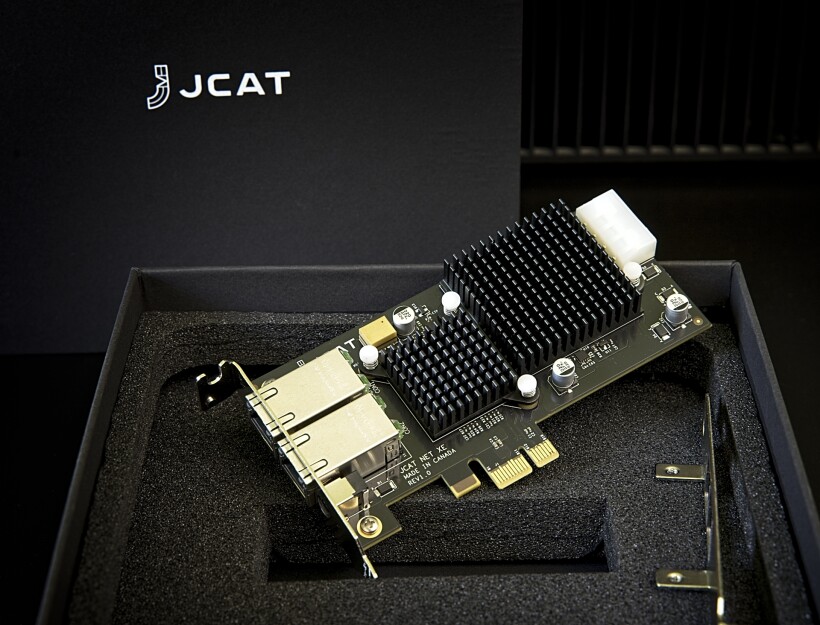
It may seem that even all these advantages combined amounted to not that much, but the scale of the changes/improvements meant a difference of almost whole class between the sound provided by the Femto version and the XE one. The former offered already a very, very good sound, the latter enhanced the performance to a remarkable, fantastic one. Certainly a lot will depend on, firstly, the DAC receiving the signal, and secondly, the USB cable used to transfer the signal. Both LampizatOr Pacific and the top USB cable from David Laboga used in this comparison, the Digital Sound Wave Ruby, represent a very high level, so they were able to take a full advantage of every extra piece of information provided by XE card and emphasize the differences between both versions. The Femto wasn’t crushed in terms of performance by the XE, so the difference was not that huge as between an integrated LAN port and one in the NET XE card, but only because Femto was already a great card, and both competitors were partnered with the same INITIO 3 linear power supply. There is no doubt, however, that the JCAT USB Card XE is yet another big step in the right direction. I call it the right direction because it means that the sound of a digital system becomes… less digital :).
JCAT USB+LAN Ground Conditioner
From the very beginning of this test, I used the JCAT USB + LAN Ground Conditioner connected to unused USB and LAN ports in my server. This approach was in line with the manufacturer’s suggestion, who claimed that this product would present its full potential only a few days after being connected to the system. For some time now I have been using another grounding solution from Japan in my system, namely the Acoustic Revive RGC-24 TripleC-FM. The difference between them is that the JCAT product is plugged into the server (after all, free USB and LAN ports are needed), while the Acoustic Revive in my system is connected to the Pacific’s grounding terminal. Plus, the Japanese device is a round box with a detachable cable, and the Polish product has a form resembling a power cable (which, as already explained, it is not!) and one plugs it into a (grounded) wall socket. So while assessing other JCAT products and performing all the comparisons I did not even try to ascertain whether the Ground Conditioner contributed in any way to the sound quality (not even after a few days of it being connected to the system). Only after evaluating all the other products did I go back to this issue.
The problem with testing the JCAT USB + LAN Ground Conditioner is that since it shows its full capabilities only after a few days of being permanently connected to the server, quick comparisons consisting in connecting and disconnecting it are pointless. Therefore, I left it in the system and started comparisons plugging and unplugging the Acoustic Revive. I played selected songs, pausing them every few dozens of seconds in Roon and using the pause to connect or disconnect the latter. The changes, or simply put, the improvements brought about by combining these two solutions, were easy to spot. Yet the scale of them was not the same as, for example, when I replaced the Femto USB card with the XE – in the latter case they were undoubtedly greater. What I found interesting was the fact the Acoustic Revive’s product seemed to complement JCAT’s. When comparing the sound with only the JCAT USB + LAN Ground Conditioner in the system, and both of them at the same time, it was obvious that the latter combination added some weight to the sound, deepened it. It became more tangible / present, and everything seemed clearer as it was presented against a blacker background. Another contribution of the Japanese product was also even greater fluidity and smoothness of the sound, or, to put it differently, yet another, even if a small, step towards what if often called an “analog”, or rather “non-digital” sound.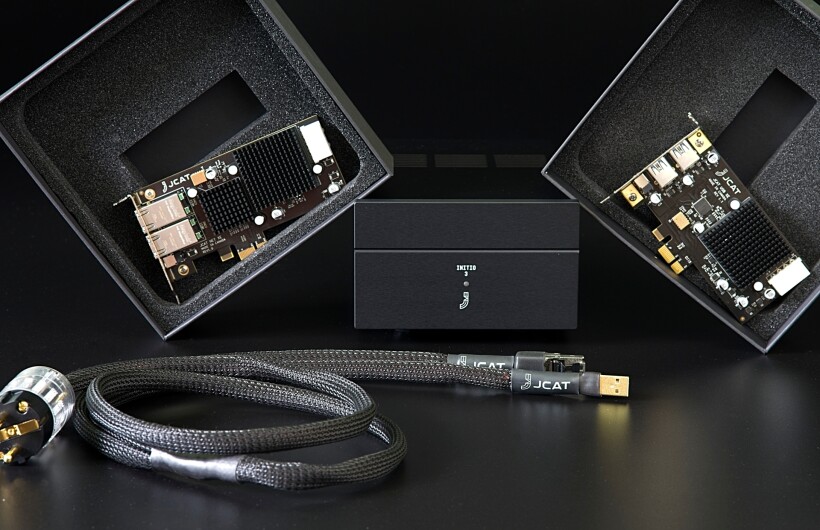
The second stage of the listening session was the time spent only with the JCAT in the system, without the Acoustic Revive, and then disconnecting even the former. A deterioration in sound quality is usually even more obvious than an improvement. That is why it was almost immediately clear that the sound of the system without any ground conditioner while still quite clean, definitely wasn’t as clear, as focused, as precise as with the JCAT. Without the latter, some minor details and subtleties were lost somewhere in the background, the resolution somewhat lowered, and these, now missing, elements were what due to the ground conditioning made sound richer and fuller. The intensity of the colors also faded a bit, and the texture of the sounds was not presented so distinctly as before. The presentation lacked some of its previous openness, there was not that much air in it, the stage was not as big and the acoustic cues caught in these recordings lost some of their significance (I used a lot of live recordings during my auditions).
Let me be clear – the performance of the system without any ground conditioning was still really good as disconnecting the JCAT ground conditioner did not make the system unusable anymore, no sonic catastrophe occurred. It’s just that once I got used to a better, improved, higher quality sound, even smallest degradation annoyed me and seemed, at least at first, bigger than it really was. It was still a great sound, but simply not as good as with the JCAT, and, let me repeat it again, the simultaneous use of the tested product and the Acoustic Revive’s raised the bar even higher. So is it worth spending a not so small amount on JCAT USB + LAN Ground Conditioner? A lot depends on how good your system already is, because (probably contrary to appearances) the better it is, the more noticeable this product’s impact will be. If, for example, I were to replace the Femto USB card with an XE or buy a ground conditioner for the former, I would replace the card (first) and treat the conditioner as the icing on the cake. Of course, it may happen that under certain conditions the conditioner will make a bigger difference in some systems, so if you have a chance, give it a try yourself to find out how will it behave in your system.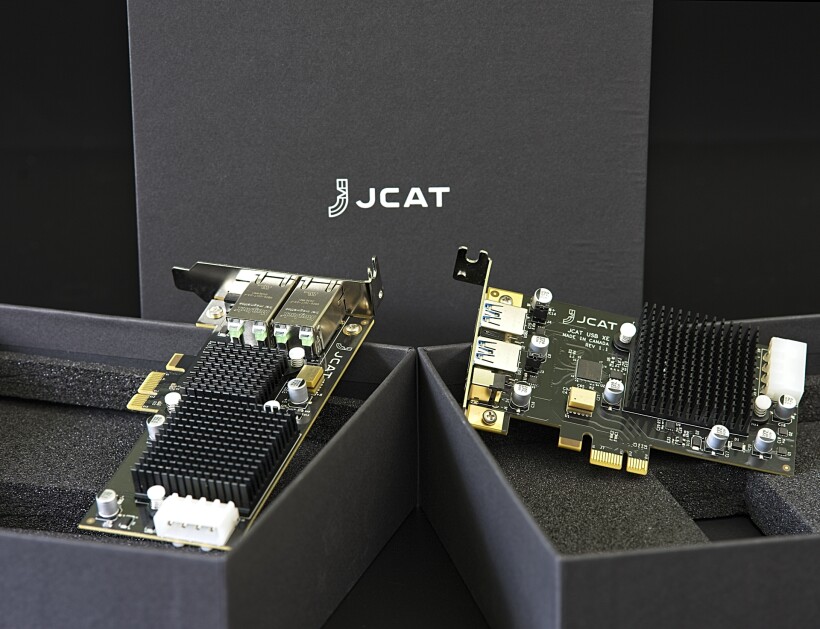
Summary
Summing up this review let me just say, that I believe that replacing the Femto USB card with the JCAT NET XE one is definitely worth the additional cost, although the latter may require one of the JCAT’s own high quality power supplies (or another one of equal class). If you already own such a PS, a card upgrade or purchasing the top, XE model is a no-brainer. In the case of the NET XE card, I were not in a position to compare it with its predecessor (I simply didn’t need such card until recently, as my DAC did not feature LAN input), and in comparison to a motherboard’s integrated port the XE card simply offers a completely different, way higher level of performance. Of course, the difference was even bigger because the card required an external high-class linear power supply. The latter, in my case INITIO 3, works perfectly with both cards, resulting with them offering a fuller, richer, more powerful, more dynamic sound. The competitor in my case was the HYPSOS Ferrum, which pushed the sound towards greater purity, transparency and precision, but at the cost of bit lesser richness and saturation. This does not mean that any of these two linear power supplies really lacked anything, but only that each of them achieved a fantastic performance using slightly different means. And finally the JCAT USB + LAN Ground Conditioner. If you do not use any ground conditioner in your PC-based system, the JCAT itself will do a really good job, but you need to give it and yourself (!) a few days before making a final assessment and fully appreciating the small, but quite significant changes/improvements that it introduces to the sound. However, if you already have one, especially if it is connected to a DAC, like in my case the Acoustic Revive RGC-24 TripleC-FM is, you should still try the JCAT product. It may turn out to be better, or, as I found it in my system, two different solutions may perfectly complement each other, becoming the final touch that the performance of your digital system needs.
Technical specifications (according to the manufacturer):
JCAT USB Card XE
- PCI Express USB Card for High-End Audio
- Plug & Play in any PC or mini PC with a PCIe slot
- Extreme sound quality improvement for any USB DAC or USB-DDC
- State-of-the-art LT3045 linear regulators and filters eliminate noise interferences from a PC
- No switching power supplies anywhere
- State-of-the-art ±0.005 (±5 ppb) stability Emerald OCXO (oven controlled oscillator) delivers the most stable timing in the presence of environmental stressors such as airflow, temperature perturbation, vibration, shock, and electromagnetic interference (EMI)
- Highest quality industrial grade components with operating temperature range from -40*C to +85*C
- Next generation low latency & low noise ASM3142 USB 3.1 host controller
- Gold plated high durability EMI shielded USB connectors
- Two High-End USB Audio outputs supporting Low Speed (1.5 Mbps), Full-Speed (12 Mbps), Hi-Speed (480 Mbps) and Super-Speed (5 Gbps) data rates
- Supports all lossless formats and sample rates
- External PSU option eliminates computer as the source of power for lowest noise & best sound quality (requirements for the PSU: 5V/1.5A min)
- 5V PSU can be supplied via 2.1/5.5mm center-positive DC jack connector or via LP4 molex connector (OPTIMO 3 DUO recommended for best SQ)
- Both full-size and low-profile laser cut PCI-e brackets included
- All x1-x16 lane PCI Express 2.0 slots supported
- Supported operating systems: Windows (all editions), Linux, Mac OS (10.14 or later)
JCAT NET Card XE
- Audiophile PCI Express GbE LAN adapter
- Plug & Play in any PC or mini PC with a PCIe slot
- Extreme sound quality improvement for any music server, network player/DAC, streaming bridge or Audio PC
- Improves music playback from cloud services (TIDAL, QOBUZ etc) as well as files stored on local music servers
- State-of-the-art LT3045 linear regulators and filters eliminate noise interferences from PC
- Truly linear design: no switching power supplies
- Cutting edge ±5 ppb stability Emerald OCXO (oven controlled oscillator) delivers the most stable timing in the presence of environmental stressors such as airflow, temperature perturbation, vibration, shock, and electromagnetic interference (EMI)
- Highest quality industrial grade components with operating temperature range from -40*C to +85*C
- Enterprise level high performance Intel i350 Ethernet controller
- Gold plated high durability EMI shielded RJ-45 connectors with built-in 12-core transformers for improved isolation
- Two audiophile grade network adapter ports supporting up to 1Gbit connection speeds
- LED-off feature to counteract noise
- External PSU option eliminates computer as the source of power for lowest noise & best sound quality (requirements for the PSU: 5V/1.5A min)
- 5V PSU can be supplied via 2.1/5.5mm center-positive DC jack connector or via LP4 molex connector (OPTIMO 3 DUO recommended for best performance)
- Low-profile & full-height laser cut PCIe brackets included
- All x1-x16 lane PCI Express 2.0 slots supported
- Supported operating systems: Windows (all editions) and Linux; Works natively with roon ROCK
JCAT INITIO 3
- Designed and fine-tuned with ONLY the highest audio quality in mind, INITIO 3 will greatly improve sonic performance of JCAT USB & NET cards or any other low current audio component
- Based on flagship OPTIMO 3 DUO design, INITIO 3 is built around the same JCAT proprietary Linear Voltage Regulator board and JCAT ultra-fast low noise rectifier
- Truly 100% linear design utilizing state-of-the-art linear voltage regulators guarantees stable operation and superb measured performance
- Bespoke transformer with magnetic and electrical shielding is sealed with epoxy resin which greatly reduces harmful vibrations
- Equipped with only premium quality components – all capacitors, sockets and connectors are of quality that you would expect from a JCAT product
- Comes with one shielded audio-grade DC cable (1.2m). Substantial 0.8mm2 cross section of conductors ensures proper energy transfer to load
- Chassis made of single sheet of bent steel ensures high rigidity and low mechanical resonance while anodized aluminum front adds elegance
- INITIO features multiple protection mechanisms to guarantee safe and trouble-free operation for many years
- Manufactured in EU with 110-240V AC input.
JCAT USB+LAN Ground Conditioner
- High performance USB Type A & RJ45 to AC plug grounding cable
- Handcrafted using the very best high purity OCC copper multi-strand wire
- Advanced shielding
- The positive effect will improve up to one week from the installation
- Excellent results in combination with USB Card FEMTO & NET Card FEMTO
- Available with EU Schuko, US & UK AC connectors. Connector to be specified upon placing an order
- Standard length is 1.3m
Prices (when reviewed):
- JCAT USB Card XE: 800 EUR
- JCAT NET Card XE: 800 EUR
- JCAT INITIO 3: 750 EUR
- JCAT USB+LAN GROUND CONDITIONER: 500 EUR
Manufacturer: JCAT
Associated equipment:
- Analogue front end: J.Sikora Standard MAX turntable, J.Sikora KV12 tonearm, AirTight PC-3, phonostages: Grandinote Celio mk IV, ESE Lab Nibiru V 5.
- Digital source: a passive, custom server with WIN10, Roon, Fidelizer Pro 7.10, JCat USB Femto card with Bakoon power supply, KECES P8 linear power supply for PC, JCAT USB Isolator
- D/A Converter: LampizatOr Pacific +Ideon Audio 3R Master Time (USB signal regenerator)
- Power amplifiers: GrandiNote Shinai, Art Audio Symphony II (modified)
- Preamplifier: Audia Flight FLS1
- Loudspeakers: GrandiNote MACH4, Ubiq Audio Model ONE Duelund Edition.
- Interconnects: Hijiri Million, Hijiri HCI-20, TelluriumQ Ultra Black, KBL Sound Zodiac XLR, David Laboga Expression Emerald USB, TelluriumQ Silver USB
- Speaker cables: LessLoss Anchorwave
- Power cables: LessLoss DFPC Signature, Gigawatt LC-3
- Power: Gigawatt PF-2 MK2 and Gigawatt PC-3 SE Evo+; a custom power line with Gigawatt LC-Y in-wall cable; Gigawatt G-044 Schuko and Furutech FT-SWS-D (R)
- Racks: Base VI, Rogoz Audio 3RP3/BBS
- Anti-vibration accessories: ROGOZ-AUDIO SMO40 and CPPB16 platforms and ROGOZ AUDIO BW40MKII feet, Franc Accessories Ceramic Disc Slim Feet and Wood Block Platform


